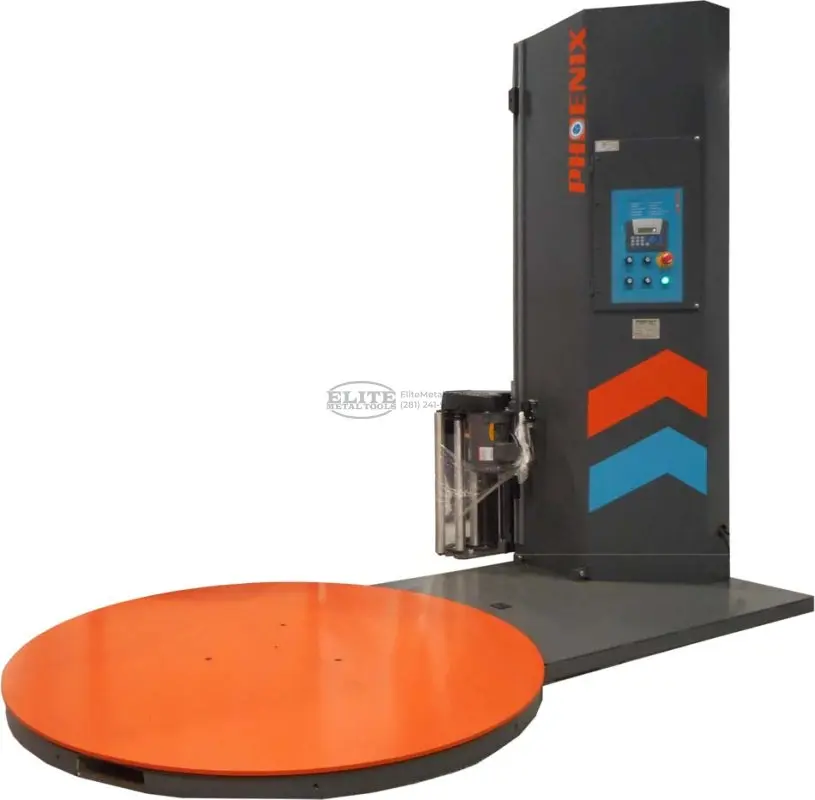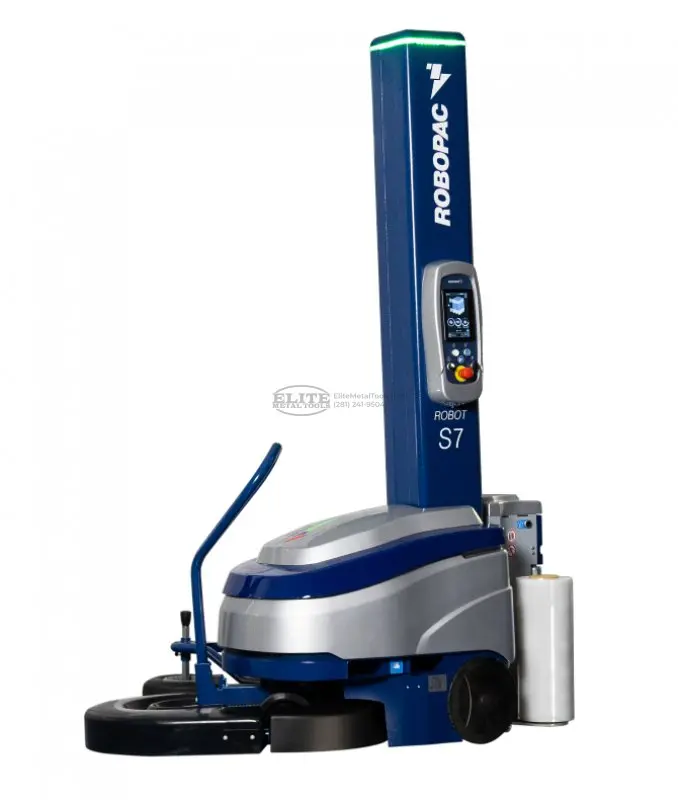Elite Metal Tools Articles
Industry news, tips, and updates on all things Elite Metal Tools
Semi-Automatic Stretch Wrappers - Let's Learn About
Semi-Automatic Stretch Wrappers: Enhancing Packaging Efficiency and Stability
Introduction: In today's fast-paced world of manufacturing and distribution, optimizing packaging processes is crucial for businesses seeking to improve efficiency, reduce labor costs, and ensure product stability during transportation. Semi-automatic stretch wrappers have emerged as a popular solution, bridging the gap between manual labor and fully automated systems. This article will explore the history, benefits, maintenance, and future trends of semi-automatic stretch wrappers. Additionally, we'll delve into key considerations for choosing the right machine and showcase real-life case studies. Brands like Robopac and Phoenix Wrappers will be highlighted for their contributions to this industry. Let's begin!
History of Semi-Automatic Stretch Wrappers: The concept of stretch wrapping dates back to the mid-20th century when businesses sought efficient ways to secure loads on pallets. Initially, manual hand wrapping was the norm, but it was time-consuming and led to inconsistent results. Semi-automatic stretch wrappers were introduced to address these challenges.
In the 1970s, the first semi-automatic stretch wrapping machines appeared, utilizing a turntable design. These machines could rotate the pallet while a stretch film was applied manually or using a film-clamp mechanism. The introduction of this technology significantly improved packaging speed and load stability.
Over the years, advancements in materials, technology, and engineering have led to more sophisticated semi-automatic stretch wrappers. Today, they are widely used in various industries, ranging from food and beverage to pharmaceuticals and logistics, where fast and secure packaging is essential.
Benefits of Using Semi-Automatic Stretch Wrappers in Packaging Operations: Semi-automatic stretch wrappers offer numerous advantages, making them indispensable assets for modern packaging operations. Some key benefits include:
-
Increased Efficiency: Semi-automatic machines can wrap pallets faster than manual methods, boosting overall productivity and reducing labor costs.
-
Consistent Load Stability: With precise tension control mechanisms, these wrappers ensure consistent film application, leading to better load containment and reduced product damage during transit.
-
Labor Savings: While not fully automated, semi-automatic stretch wrappers still reduce the physical strain on workers and require less operator effort compared to manual wrapping.
-
Versatility: They can accommodate various load sizes and shapes, making them suitable for a wide range of packaging needs.
-
Cost-Effectiveness: Semi-automatic models are more budget-friendly than fully automated systems, making them an attractive option for businesses seeking efficiency without a significant upfront investment.
How to Choose the Right Semi-Automatic Stretch Wrapper for Your Business: Selecting the most suitable semi-automatic stretch wrapper depends on several factors unique to your packaging requirements. Here are some key considerations:
-
Load Size and Weight: Consider the largest and heaviest pallets you need to wrap. Ensure the machine's turntable and weight capacity can handle your specific needs./product/17636
-
Film Type and Thickness: Different products and industries may require specific types of stretch film. Ensure the machine is compatible with the film you intend to use.
-
Throughput and Production Volume: Evaluate your packaging volume to determine the appropriate wrapping speed and machine durability.
-
Automation Level: Some semi-automatic wrappers offer advanced features, such as auto-cut and auto-clamp functions, which can further streamline your operations.
-
Safety Features: Look for machines with safety mechanisms like emergency stop buttons and safety fences to protect operators.
Top Tips for Properly Maintaining Semi-Automatic Stretch Wrappers: Regular maintenance is essential to keep semi-automatic stretch wrappers in top condition and prolong their lifespan. Here are some maintenance tips:
-
Cleaning and Lubrication: Regularly clean the machine, removing dust and debris. Lubricate moving parts to prevent wear and ensure smooth operation.
-
Inspect Wear Components: Routinely check and replace wear components like film rollers and pre-stretch carriages to maintain consistent wrapping quality.
-
Calibration and Adjustment: Periodically calibrate and adjust the tension and wrapping parameters to suit the load characteristics.
-
Operator Training: Properly train operators to use the machine safely and efficiently, reducing the risk of operational errors.
Improving Efficiency: Integrating Semi-Automatic Stretch Wrappers into Your Packaging Line: Integrating semi-automatic stretch wrappers into your packaging line requires careful planning and consideration of workflow. Here are some strategies to maximize efficiency:
-
Positioning: Place the stretch wrapper strategically in the packaging line to minimize material handling and optimize workflow.
-
Automation Integration: For seamless operations, consider integrating the stretch wrapper with other automated machinery in your packaging line.
-
Standard Operating Procedures (SOPs): Develop SOPs for loading, wrapping, and unloading to ensure consistency and reduce downtime.
Understanding the Differences Between Semi-Automatic and Automatic Stretch Wrappers: While both semi-automatic and automatic stretch wrappers serve similar purposes, they differ in their level of automation:
-
Semi-Automatic Stretch Wrappers: Require some operator intervention, such as attaching the film and starting the wrapping process. They are ideal for medium-volume packaging lines./product/16114
-
Automatic Stretch Wrappers: Operate with minimal or no operator intervention, automatically sensing and wrapping loads. They are suitable for high-volume packaging operations.
Semi-Automatic Stretch Wrappers: Sustainable Packaging Practices and Safety Measures: Sustainability is a growing concern in the packaging industry. Semi-automatic stretch wrappers can contribute to sustainable practices by:
-
Film Usage Optimization: Advanced pre-stretch mechanisms can stretch the film efficiently, reducing film consumption and waste.
-
Recyclable Materials: Choosing recyclable stretch film options supports environmentally-friendly packaging initiatives.
Safety is paramount when operating stretch wrapping machines. Implementing safety measures like operator training, safety fences, and regular maintenance ensures a safe work environment.
Case Studies: Real-Life Applications of Semi-Automatic Stretch Wrappers in Various Industries: To understand the real-world impact of semi-automatic stretch wrappers, let's explore some case studies showcasing their successful applications:
-
Food and Beverage Industry: A food manufacturing company increased production efficiency by 30% using a semi-automatic stretch wrapper, reducing packaging costs and minimizing product damage during transportation.
-
Pharmaceutical Sector: A pharmaceutical distributor improved load stability and met strict safety regulations by implementing a semi-automatic stretch wrapper with precise tension control.
Future Trends in Semi-Automatic Stretch Wrapping Technology and Innovation: As technology evolves, so will semi-automatic stretch wrapping. Key trends and innovations include:
-
Smart Automation: Integration of sensors and data analytics for better load profiling and optimal wrapping patterns.
-
Eco-Friendly Solutions: Development of biodegradable and compostable stretch films to support sustainable packaging initiatives.
-
Advanced Safety Features: Implementation of more advanced safety mechanisms to minimize operator risks.

